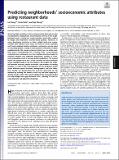Predicting neighborhoods’ socioeconomic attributes using restaurant data
Author(s)
Dong, Lei; Ratti, Carlo; Zheng, Siqi
DownloadPublished version (953.6Kb)
Publisher Policy
Publisher Policy
Article is made available in accordance with the publisher's policy and may be subject to US copyright law. Please refer to the publisher's site for terms of use.
Terms of use
Metadata
Show full item recordAbstract
Accessing high-resolution, timely socioeconomic data such as data on population, employment, and enterprise activity at the neighborhood level is critical for social scientists and policy makers to design and implement location-based policies. However, in many developing countries or cities, reliable local-scale socioeconomic data remain scarce. Here, we show an easily accessible and timely updated location attribute—restaurant—can be used to accurately predict a range of socioeconomic attributes of urban neighborhoods. We merge restaurant data from an online platform with 3 microdatasets for 9 Chinese cities. Using features extracted from restaurants, we train machine-learning models to estimate daytime and nighttime population, number of firms, and consumption level at various spatial resolutions. The trained model can explain 90 to 95% of the variation of those attributes across neighborhoods in the test dataset. We analyze the tradeoff between accuracy, spatial resolution, and number of training samples, as well as the heterogeneity of the predicted results across different spatial locations, demographics, and firm industries. Finally, we demonstrate the cross-city generality of this method by training the model in one city and then applying it directly to other cities. The transferability of this restaurant model can help bridge data gaps between cities, allowing all cities to enjoy big data and algorithm dividends.
Date issued
2019-07-15Department
Massachusetts Institute of Technology. Department of Urban Studies and Planning; Massachusetts Institute of Technology. Media LaboratoryJournal
Proceedings of the National Academy of Sciences of the United States of America
Publisher
Proceedings of the National Academy of Sciences
Citation
Dong, Lei, Carlo Ratti and Siqi Zheng. "Predicting neighborhoods’ socioeconomic attributes using restaurant data." Proceedings of the National Academy of Sciences of the United States of America 116 (2019): 15447-15425 © 2019 The Author(s)
Version: Final published version
ISSN
0027-8424
1091-6490
Keywords
Multidisciplinary